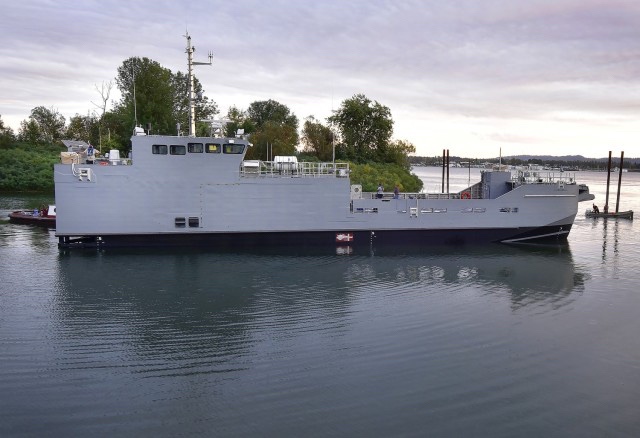
VANCOUVER, Wash. — The Army’s Maneuver Support Vessel (Light), or MSV(L), prototype was launched Oct. 10 at the Vigor, LLC marine fabrication facility in Vancouver. The launch is significant, as the MSV(L) represents the first of a new class of Army Watercraft.
The MSV(L) will replace the Landing Craft Mechanized-8, (LCM-8,) a Vietnam-era watercraft that is unable to transport some of today’s equipment due to the weight of modern combat vehicles. MSV(L) is a modernized landing craft that will improve the speed and effectiveness of the Army’s dynamic force repositioning.
The MSV(L) features increased payload capability; providing access within the Maritime Domain; increased speed and maneuverability to move the Army faster; and improved draft for greater geographical access.
“Launching the MSV(L) prototype, a brand-new, first-in-class vessel is a major achievement for us to celebrate,” said Col. Beth Behn, the Army’s chief of transportation. “Not only does this prototype represent the first of its kind for the Army as a digital vessel, but also, the overall team has surmounted several hurdles having to do with COVID-19-related workforce and supply-chain issues. I couldn’t be more proud of this partnership to become one step closer to providing Army Mariners the world over a truly modernized capability.”
“The MSV(L) represents the first new major watercraft system acquisition in more than 20 years representing the U.S. Army’s commitment to Army Watercraft modernization,” said Brig. Gen. Samuel L. (Luke) Peterson, the Army’s program executive officer for Combat Support and Combat Support (PEO CS&CSS.) “Our Product Manager, Army Watercraft Systems, has worked very closely with our Army enterprise partners and Vigor to ensure a successful launch. The team has done an outstanding job working through some fairly significant schedule challenges in order to get to where we are today. This launch is the direct result of the collaborative work between many dedicated professionals from both the Army and Vigor.”
The Army awarded Vigor in late 2017 a 10-year contract for the development and production of up to 36 of the new watercraft. In September 2019, Vigor and the Army laid the keel in a ceremony also held in Vancouver. The current Army Acquisition Objective is to build 13 vessels, according to Wolfgang Petermann, project manager, Transportation Systems, PEO CS&CSS. The Army’s strategy for the MSV(L) has centered on integrating mature commercial off-the-shelf subsystems into a new hull form, which takes advantage of the marine industry design innovation and competition, he added.
Army watercraft enables commanders to transport and sustain combat-configured equipment with personnel, vehicles and sustainment cargo, through fixed, degraded and austere ports, inland waterways, remote and unimproved beaches and coastlines for missions across the spectrum of military operations. The improved maneuverability and increased speed capability that the MSV(L) brings to bear will provide a better watercraft for operating in inter-coastal areas, rivers and inland waterways, and in anti-access/area-denial environments.
The length of MSV(L) is 117 feet. It will have a speed of 21 knots fully laden and 30 knots unladen. Its range will be 360 nautical miles when fully laden. Eight Army Mariners will crew the MSV(L).
Each vessel’s payload will be 82 short tons, which means it can haul one combat configured M1 Abrams tank, or two Stryker combat vehicles, or four Joint Light Tactical Vehicles, as well as multiple other payload configurations.
MSV(L) now enters builder’s trials, which are designed to finalize Vigor’s fabrication and commissioning activities. Builder’s trials are slated for completion in November. They will be followed by extended acceptance trials, led by the Army’s Product Manager, Army Watercraft Systems and the Army Test and Evaluation Command, to verify that the watercraft meets its intended requirements.
A low-rate initial production decision on the Maneuver Support Vessel (Light) is targeted for early 2023. The prototype is slated for delivery to the Army Mariner community headquartered at Joint Base Langley-Eustis in early 2024.
PEO CS&CSS is one of 12 Army Program Executive Offices reporting to the Assistant Secretary of the Army (Acquisition, Logistics & Technology.) Its military and Army civilian acquisition professionals are charged with the lifecycle management for the majority of the Army’s Engineer, Ordnance, Quartermaster, and Transportation systems, which account for roughly 20 percent of all the equipment the Army’s Active, Reserve and National Guard components use.
By Rae Higgins, U.S. Army Program Executive Office Combat Support & Combat Service Support


13 vessels is kind of discouraging.
I mean, the Army doesn’t exactly have dozens of the ship this is intended to replace (LCM-8). A grand total of two of those ships were used throughout the entirety of the 2003 Iraq war.
That would change drastically in a conflict with China. The Army will have a hard time maneuvering around the South China Sea if it has to wait for a maritime uber
Considering from articles I have read the Army currently has 36-40 LCM-8’s but is replacing them with 36 of the new MSVL, if it is 13 then the Army as the Title 10 lead for Logistics will be seriously lacking especially if there ever is a conflict in which the MSVL is needed.
It’s a C-17 for the water!
Did nobody else catch that the article about a landing craft was written by someone named Higgins?
If these craft are intended for operations in a potential conflict against China, I hope someone in the Army pulled a chart and realized China is more than 360NM from Fort Eustis. I wonder how they plan on getting these craft into that theater?